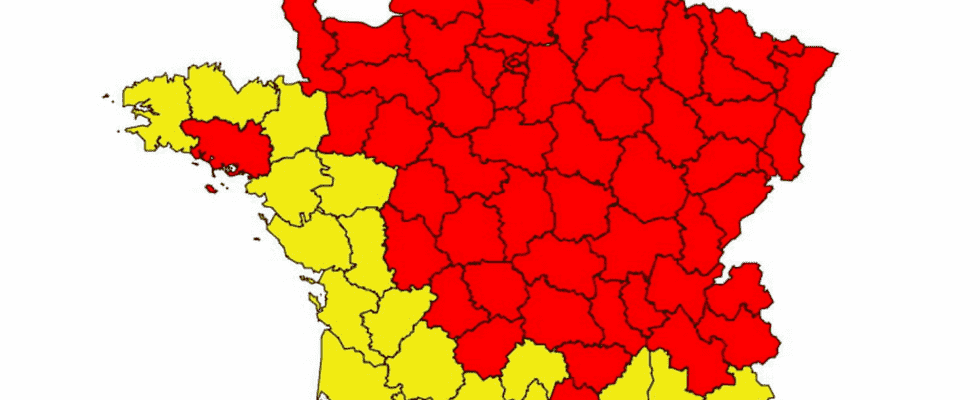ALLERGY CARD 2022. The return of good weather promotes the dispersal of pollen in France. For Easter, the long weekend will be marked by birch pollen. In which departments is the allergic risk the highest in this month of April? Image and advice for allergy sufferers.
[Mis à jour le 15 avril 2022 à 16h50] Itching in the eyes, in the throat, itchy, runny nose… A pollen allergy is manifested by several characteristic symptoms. In Francethe first allergies start in February with the cypress pollens, then arrive in april those of grassesof birch (especially in the north of France) and continue thesummer with those of ambrosia. The study of the content of the air in biological particles (pollens in particular) which can have an impact on the allergic risk for the population is carried out by the National Aerobiological Surveillance Network (RNSA), an association created in 1996 to continue the work carried out since 1985 by the Aerobiology Laboratory of the Pasteur Institute in Paris. According to the last April 15 newsletterthe good weather and the mildness announced for the next few days promote the dispersal of pollen, especially that of birch. The risk of allergy will be high over a large part of north-eastern France. What are the pollens currently present in France? Which departments are in the red? What advice for allergy sufferers?
What are the pollens currently present in France?
The pollen produced by flowers is made up of tiny grains that are used for plant reproduction. The main manifestations of pollen allergy are allergic rhinitis (or allergic rhino-conjunctivitis), also called “hay fever”. It exists three main categories of pollen : tree pollens (birch, plane tree, etc.), grasses (wheat, oats, etc.) and herbaceous plants (nettle, ambrosia, etc.).
In France, the main plant species responsible for allergies are:
- grasses (April to July)
- birch (April, especially in northern France)
- the cypress (February to April)
- mugwort ragweed (August, September)
At the moment, according to National Aerobiological Monitoring Network (RNSA):
- the birch pollen cause a high risk of allergy in many departments with significant concentrations from Normandy to the Grand-Est and from Hauts-de-France to Auvergne – Rhône-Alpes. Those allergic to these pollens must remain vigilant.
- the ash pollen (Oleaceae family) are decreasing and a low level allergy risk.
- the oak and grass pollen are gaining momentum and continuing their progression from west to east with a low level risk for the moment.
- the plane tree pollen are also present throughout the territory, with a risk of allergy that varies from low to medium depending on the department.
- The pCupressaceae ollens (cypressjunipers, cedars, etc. are clearly losing momentum in the south with a risk of allergy no longer exceeding the low to very locally average level.
- The Urticaceae pollen (parietaires) are more and more present with a risk of allergy which can reach the average level as in the Var.
- The willow, hornbeam, and poplar pollens spread like Easter eggs with however a risk of allergy which will not exceed the low level.
In which departments is the risk of allergy high?
List of departments where the risk of allergy is high according to the National Aerobiological Monitoring Network : Pas-de-Calais (62), North (59), Somme (80), Aisne (02), Ardennes (08), Marne (51), Aube (10), Meuse (55), Morbihan (56), Haute-Marne (52), Moselle (57), Seine-Maritime (76), Oise (60), Manche (50), Calvados (14), Eure (27), Val-d’Oise (95), Vienne ( 86), Seine-et-Marne (77), Yvelines (78), Orne (61), Mayenne (53), Sarthe (72), Eure-et-Loire (28), Essonne (91), Seine-et-Marne (77), Haute-Loire (43), Lozère (48), Sarthe (72), Loir-et-Cher (41), Loiret (45), Loire (42), Yonne (89), Côte-d’Or (21), Haute-Saône (70), Territory of Belfort (90), Haut-Rhin (68), Vosges (88), Bas-Rhin (67), Puy-de-Dôme (63) , Meurthe-et-Moselle (54), Rhône (69), Allier (03), Creuse (23), Indre (36), Cher (18), Nièvre (58), Mayenne (53), Seine-Saint-Denis (93), Hauts-de-Seine (92), Isère (38), Ain (01) Val-de-Marne (94), Savoy (73), Paris (75).
What to do if you are allergic to limit the symptoms?
The RNSA recommends that allergy sufferers:
- to follow their treatments and consult the doctor in case of symptoms,
- regularly consult the pollen vigilance map on the RNSA website
- rinse your hair at night,
- ventilate at least 10 minutes a day before sunrise and after sunset,
- avoid drying clothes outside,
- keep car windows closed to prevent pollen from entering the passenger compartment,
- avoid outdoor sports activities that lead to overexposure to pollen.
- Also beware of air pollution, which can exacerbate pollen allergies.
What are the differences between the symptoms of an allergy and Covid?
The priority for allergy sufferers, despite the coronavirus epidemic, is to maintain their background treatment to better control asthma and avoid complications. Caution of do not confuse the symptoms of Covid-19 and pollen allergy.
As the RNSA reminds us, the dry cough or respiratory problems linked to asthma are indeed quite similar to those of the first symptoms of Covid-19 infection, but what makes the big difference for Covid-19 is flu syndrome (pain, body aches, fever). If in doubt, do not hesitate to consult your doctor or an allergist.
